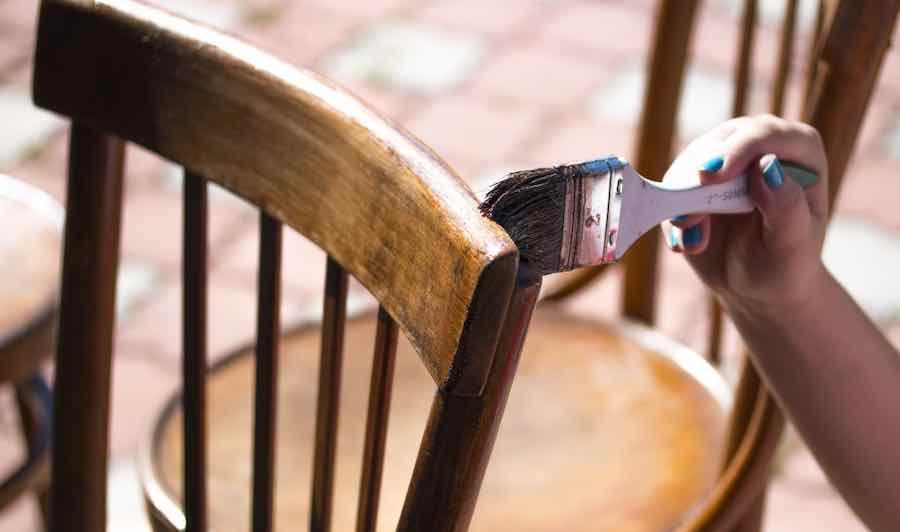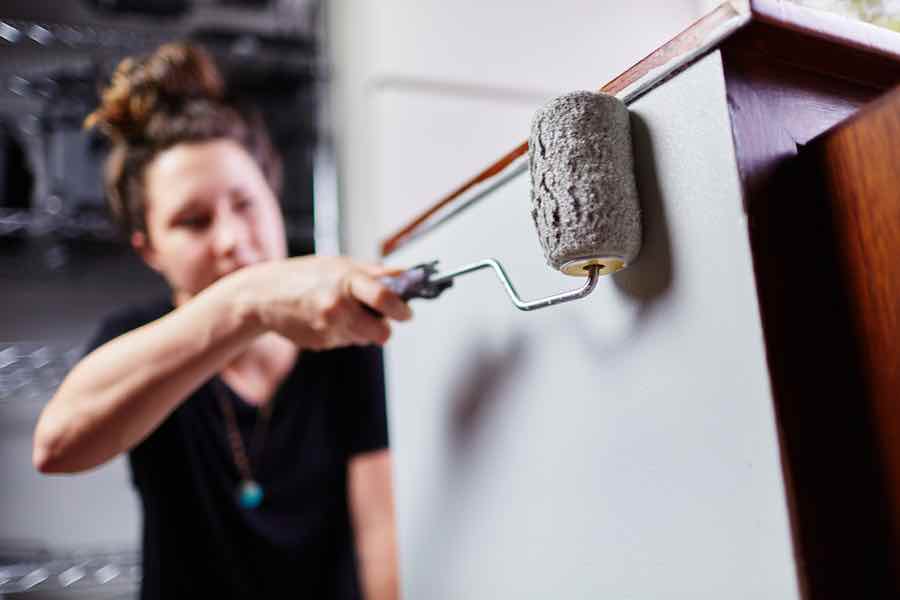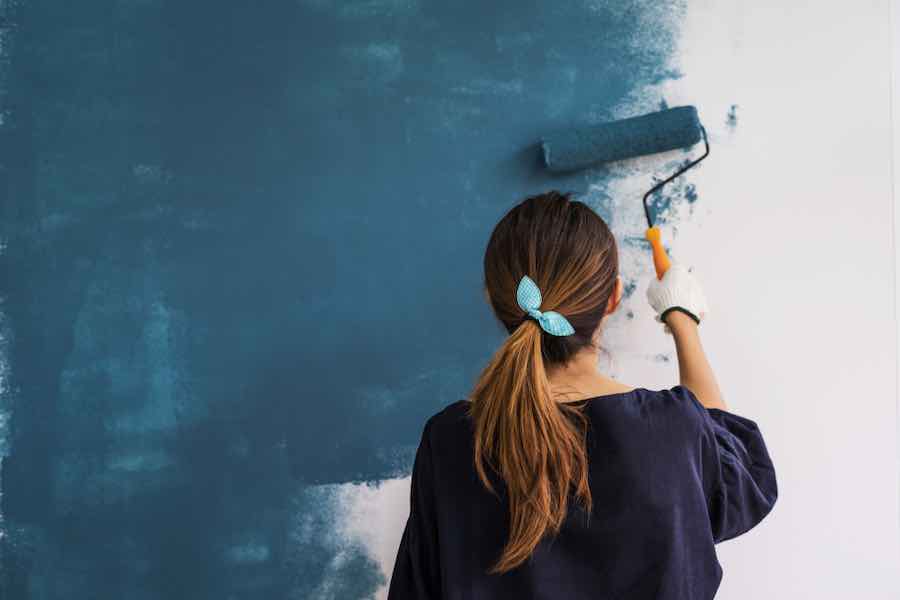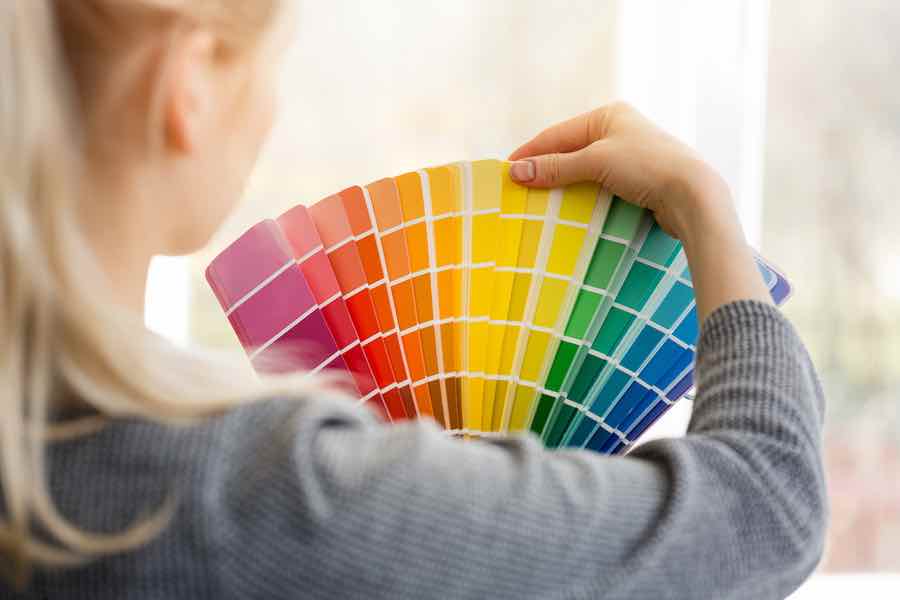When starting your paint or stain project, you need to make sure you’re using the right finish for the job. Depending on what you’re painting and what kind of look you’re going for, you need to make sure you’re buying the best finish possible for your project. If you don’t do this, your project may not look the way it’s supposed to!
So, how do you choose? There are so many different types of finishes on the market, but the two we’ll be discussing are stain and paint finishes. Below, we’re directly comparing the two, telling you all about each type in depth so you can make the choice for yourself.
You are watching: Stain vs. Paint: The Pros and Cons of Each Finish
Paint vs Stain: The Biggest Differences
- Appearance: The most significant difference is the appearance. Staining is used to enhance the natural beauty and grain of the wood while painting is used to cover the wood and give it a uniform color.
- Transparency: Stains are transparent or semi-transparent, which allows the natural grain of the wood to show through. In contrast, paint is opaque, covering the grain completely.
- Maintenance: Stained wood requires more maintenance than painted wood. Stains can fade or wear away over time, and the wood may need to be re-stained every few years. Painted wood, on the other hand, is more durable and can last longer without the need for touch-ups.
- Preparation: Staining requires less preparation than painting. Stains can be applied directly to clean, bare wood, while paint requires more preparation, such as sanding, priming, and filling in imperfections.
- Cost: Staining is usually less expensive than painting, as it requires fewer materials and less preparation time.
- Time: Staining is usually a quicker process than painting. Stains dry faster than paint, allowing for multiple coats to be applied in a shorter amount of time.
Our Top Recommended Stain Brands
Minwax: Minwax is one of the most well known brands in stains and clear coats, they offer a variety of stains, finishes, and sealers for wood surfaces that work great on furniture.
Varathane: Varathane is another popular brand that offers a range of stain products, including oil-based and water-based options. Their stains are known for their fast-drying time and rich color.
General Finishes: General Finishes is a premium brand that offers high-quality stains, topcoats, and other finishing products for wood surfaces. General Finishes products are known for their durability and professional-grade quality.
Olympic Stains: Olympic Stains are typically for larger exterior projects such as decks, fences, and wood siding.
Our Top Recommended Paint Brands
Rust-Oleum Painter’s Touch Latex Paint
Rust-Oleum Painter’s Touch Latex Paint is a water-based and durable paint that dries quickly and can be easily cleaned up with soap and water. This paint provides excellent coverage and adhesion, resists chipping, peeling, and fading, and comes in a variety of colors and finishes. It is a versatile and reliable option for painting furniture, walls, and other surfaces, and can help achieve a professional-looking finish.
Country Chic Chalk Style Paint
Country Chic Chalk Style Paint is a versatile and easy-to-use paint that is perfect for transforming furniture, home decor, and other surfaces. This paint is made with natural ingredients and provides a smooth, matte finish that can be distressed for a vintage look. Country Chic Chalk Style Paint is available in a wide range of colors, allowing you to customize your project to your liking.
Jolie Paint – Matte finish paint for Furniture, Cabinets, and More
Jolie Paint is a high-quality, matte finish paint that is eco-friendly and designed for use on furniture, cabinets, floors, walls, home decor, and accessories. It is easy to apply, quick-drying, and available in a wide range of colors, providing excellent coverage and adhesion for a durable finish. With Jolie Paint, you can achieve a beautiful and long-lasting result for your home renovation or decorating project.
All About Staining
First, let’s talk about stain. From what it is to its pros and cons, we’re breaking down everything you need to know about staining down below.
What is Paint Staining?
Staining wood is a process of adding color to the surface of wood while allowing the natural grain and texture of the wood to show through.
Stains are composed of a mixture of pigments and solvents, and come in a variety of colors and opacities. The pigments in the stain penetrate into the pores of the wood, adding color and enhancing the natural beauty of the wood. By using different types of stains and application techniques, you can achieve a range of effects, from subtle and natural to bold and dramatic.
Pros
As we mentioned, one of the biggest pros about staining is that it isn’t going to cover the original look of the furniture. Instead, the look is kept visible and even better than before. While you can choose to buy solid stains, translucent ones are also an option for those looking to totally celebrate the piece of furniture you have in front of you.
Read more : Guide to Exterior Wood Finish – Best Outdoor Polyurethanes
Stain is also wonderful because of the way that it fades over time. It happens gradually and doesn’t peel awkwardly. It also won’t damage the paint underneath the stain, even when it does fade. Whenever you notice that it starts to fade, all you have to do is reapply it.
Stain is something that you can apply several times over the lifespan of your furniture piece, so don’t worry if you have to stain it again after a year or so. Just make sure you sand down the piece before doing so (but we’ll talk about that later).
Along with looking beautiful, stain is actually beneficial for the wood of furniture. When applied, it soaks deep into the wood’s grain and helps prevent moisture from affecting or warping the structure of the piece. This also prevents rot, so adding a clear coat of stain can be much more beneficial than you may realize.
Again, if you’re looking for a way to simply enhance the way that your furniture pieces already look, stain is easily the best option. You’re not covering anything, you’re adding a layer of protection, and the original colors are more vibrant and glossy than ever before. Staining can truly make it feel as though you have a brand-new piece of furniture.
Cons
Of course, with its pros comes a few cons as well. As we hinted at above, stain does not stay nearly as long as paint does. In fact, stain will only last for a few years tops, making you have to reapply the stain about once every year.
While this process is easy, it can be frustrating to have to buy more stains year after year. Sometimes, you just want to set something and forget it, but you simply cannot with stain.
Unfortunately, some woods will simply reject the stain that you’re using. The stain, in general, can be a bit unpredictable, not always applying the way you’re hoping. Some woods just don’t hold the stain well, and you won’t see much of a difference after application.
Unfortunately, if you apply stain and find that the wood is rejecting it, you’re going to have to strip it of the stain entirely. If you leave it on the piece of furniture, it will likely ruin the whole look of your furniture.
In order to get the perfect look with your stain, it is going to take a bit of practice. You cannot just apply stain haphazardly and hope that it will work; instead, you need to practice your strokes and application to make sure that you’re achieving the look you want. Take the time to practice applying your stain before using it on a major project, otherwise, you might ruin your furniture piece.

Best For
We’re sure it’s obvious by now, but stain should only be used on wood materials. Stains are going to be best for wood tables, wood frames, wood doors-practically anything wood-based that you want to enhance, stain can do. Again, there are certain woods that won’t hold the stain as well as others, but this simply on a case-by-case basis. That’s why we mentioned stain being slightly unpredictable.
You can only apply stain to wood because of the way that the stain actually seeps into the material itself. Other surfaces do not have the ability to soak in this substance and become enhanced the way that wood does. It saturates the actual color itself, turning it into a brand-new looking piece. But, on any surface, it simply won’t make a difference.
Staining Tips
When staining wood, make sure you’re using the right type of stain. As we mentioned, you can find stains that are clear, semi-translucent, and even solid. It all just depends on the kind of look you’re going for. There are also pigment stains, dye-based stains, and even gel stains if those float your boat as well. It all depends on the type of project you’re working on.
Before you start staining, you also want to make sure that your wood is prepped properly. While you technically can add stain right on top of wood, you will get a much result if you sand the wood first. Sanding the wood will ensure a smooth, even finish that looks as professional as any woodmaker’s. You can use a sander or sandpaper, both will get the job done just fine. After sanding, make sure you wipe off all remaining residue and sand.
Pre-stain conditioner is also a helpful substance to have. As the name suggests, you want to apply this before the stain as it works to condition the surface for the stain itself. This can result in a better reception of the stain and a prettier look overall.
All About Paint
Now that we’ve told you all about stain, it’s time to learn about the opposite: paint. If you’re familiar with any of these terms, it’s going to be paint. This is the substance you’ve been playing with for years, only using it on your furniture as an adult is a whole new ball game. Here’s everything you need to know about paint, the pros and cons, and some tips to help you do it best.
What is Paint?
Paint is a type of coating that is applied to the surface of an object or material to provide color, protection, and a desired finish.
Paint is typically made up of a mixture of pigments, binders, solvents, and additives. The pigments provide the color, while the binders hold the pigment particles together and create a film that adheres to the surface of the object being painted.
Read more : Outdoor Plant Care
The solvents in paint help to dissolve and spread the other components, and then evaporate as the paint dries. Additives can be included to provide additional properties such as increased durability, faster drying time, or improved resistance to water or UV light.
Paint comes in a wide range of different colors-pretty much any color you can come up with, you can find a corresponding paint color. This allows for extreme versatility with projects; you can come up with styles and designs that match your home perfectly. Or, if you’re looking for a certain theme, there’s no shortage of paint colors to help you achieve it.
You can find various paint types, from metallic to gloss to semi-gloss and flat. Each paint has its own composition, translating differently onto surfaces. There are even specific paint types for furniture versus your walls, so you can experience the best result possible. While there is a lot to choose from, paint allows for ultimate creativity and fun.

Pros
As we mentioned, the versatility of traditional paint allows for you to truly find the color pallets of your dreams.
Regardless of the theme you have in your home or the theme you want to create, you can do that with ease through the use of different paints and paint colors. Whether you want a shabby chic look or something more modern, there are paint colors to help you achieve it.
Painting is also easier to apply (and do in general) than staining. As you saw, staining requires some serious steps prior to the actual process, and skipping these steps can be detrimental for your project.
While painting requires extra steps too, you don’t have to worry about sanding or using any complicated tools. Instead, you just need the basics: paint brushes, paint, tarps and plastics, rags, and painting trays. Pretty much anyone can paint with ease.
While painting is great for transforming a room, the whole act of doing so actually has health benefits! Studies have shown that artistic activities like drawing and painting can actually help lower your cortisol levels, which is your body’s main stress hormone. This can leave you feeling more relaxed, calm, and satisfied with your painting project.
Cons
Unfortunately, painting can prove to be a bit more expensive than staining. With staining, you really just need the stain itself, as well as a sander.
Stain isn’t nearly as expensive as paint is, and you’re going to need more paint depending on what kind of project you’re doing. Typically, painting is going to be a several-day affair, as it requires multiple layers with hours of drying in between.
If you’ve never painted before, there’s a chance that your first painting project will end up a bit streaky. This is because solid painting can take practice learning what kind of strokes are best and how to cover them well. Try practicing painting something else before actually going at your walls or furniture pieces.
Finally, paint peels. It’s an unfortunate but prevalent issue with paint, especially when exposed to too much sun. Peeling paint isn’t just unappealing looking, but it can actually damage your piece of furniture, too. Keep an eye on any paint peel, and keep your furniture pieces out of direct sunlight if possible.

Best For
As we mentioned, you can use paint for practically anything. There are paints made for your walls, paint made for your furniture, and paint made for your clothing. No matter what kind of project you’re looking to get into, there’s a good chance there’s a paint type that corresponds perfectly.
Painting Tips
If you’re a first-time painter, make sure to invest in some high-quality painting materials. Do research to see which companies appeal to you most, and which have the best reviews, especially for newer painters.
If you’re painting a room, make sure you use ample protection for the areas you’re not painting. Cover your floors, windows, and baseboards in tarp or tape to ensure that it doesn’t get ruined by the paint you’re using. Even if it drips, once you remove the tarp, everything underneath it will stay pristine.
Finally, make sure you use primer before you get started. Paint primer will ensure that your actual paint goes on much smoother and more consistently than if you just put the paint straight on the wall. In fact, it is clear when a wall has been painted with primer versus without; so, make sure you always find a high-quality primer to use before you begin painting.

Choosing Between Paint and Stain
Now that you know all about paint and stain, it’s time for you to decide what you think is best. Again, it all depends on the project you’re doing and what kind of look you’re going for. Both applications are wonderful in their own ways; they’re simply just two different finishes.
Source: https://gardencourte.com
Categories: Outdoor


